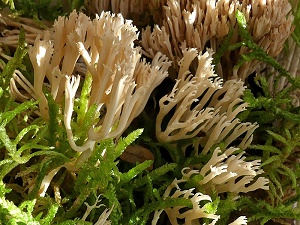| Ramaria gracilis (Pers.:Fr.) Quél. |
|
|
|
|
|
|
The fruiting body is shaped like a very branched shrub, with cylindrical branches, white to dirty white then ochre pink, without stem, but with a thin central trunk, and a base with white mycelial strands. the odour is of aniseed. The fertile surface is smooth. It grows on the ground, in coniferous woods, with spruce. The fruiting period takes place from August to October.
Distinctive features : branched, with thin branches and pointed tips, odour of aniseed; bitter taste Ramaria gracilis is rare and confined in the forest of Rambouillet, and is infrequent, more generally speaking . | ||
|
page updated on 14/01/18

